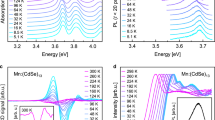Abstract
In this article, a new theoretical approach to studying light-scattering characteristics of nanosized objects based on the solution to the Thomas-Fermi equation and quasi-classical approximation is considered. It is shown that the distribution of valence electrons in the volume of metallic clusters exhibits a specific structure of “spatial zones.” With the aid of quasi-classical wave functions, expressions for the appropriate dipole moments of the transitions between the ground and excited states are obtained; the behavior of the spectrum of gold clusters depending on their sizes is studied; a comparison with existing experimental data is carried out.
Similar content being viewed by others
References
A. N. Grigorenko, A. K. Geim, H. F. Gleeson, et al., “Nanofabricated Media with Negative Permeability at Visible Frequencies,” Nature 438, 335–339 (2006).
V. A. Bogatyrev, L. A. Dykman, B. N. Khlebtsov, et al., “Measurement of Mean Size and Evaluation of Polydispersity of Gold Nanoparticles from Spectra of Optical Absorption and Scattering,” Opt. Spektrosk. 96 (1)}, 139–148 (2004) [Opt. Spectrosc. 96 (1), 128–135 (2004)].
A. S. Shalin, “Electrodynamical Response of Colloid Ensemble Taking into Account the Influence of Distant Nanoparticles,” Izv. Vyssh. Uchebn. Zaved., Fiz., No. 8, 3–11 (2006).
S. A. Maier, M. L. Brongersma, P. G. Kik, et al., “Observation of Near-Field Coupling in Nanoparticle Chains Using Far-Field Polarization Spectroscopy,” Phys. Rev. B: Condens. Matter 65, 193 408 (2002).
A. S. Shalin, “Light Scattering by Nanosize Systems with Different Space Organization,” Zh. Prikl. Spektrosk. 73 (5), 641–646 (2006).
W. Rechberger, A. Hohenau, A. Leitner, et al., “Optical Properties of Two Interacting Gold Nanoparticles,” Opt. Commun. 220, 137–141(2003)
J. Zheng, C. Zhang, and R. M. Dickson, “Highly Fluorescent, Water-Soluble, Size-Tunable Gold Quantum Dots,” Phys. Rev. Lett. 93, 077402} (2004).
J. I. Gonzales, T. H. Lee, M. Barnes, et al., “Quantum Mechanical Single- Gold-Nanocluster Electroluminescent Light Source at Room Temperature,” Phys. Rev. Lett. 93, 147402 (2004).
V. P. Krainov and M. B. Smirnov, “The Evolution of Large Clusters under the Action of Ultrashort Superintense Laser Pulses,” Usp. Fiz. Nauk 170 (9), 969–991 (2000) [Phys.-Usp. 43 (9), 901–920 (2000)].
M. I. Mishchenko, L. D. Travis, and A. A. Lacis, Scattering, Absorption and Emission of Light by Small Particles (Cambridge University Press, Cambridge, 2002).
T. V. Teperik, V. V. Popov and F. J. Garcia de Abajo “Total Resonant Absorption of Light by Plasmons on the Nanoporous Surface of a Metal,” Fiz. Tverd. Tela 47 (1), 173–175 (2005), [Solid St. Phys. 47 (1), 178–182 (2005)].
A. A. Ovchinnikov, Yu. I. Dakhnovskii, V. D. Krevchik, et al., Principles of Controlled Modulation of LowDimensional Structures (Izd. UNTsDO, Moscow, 2003) [in Russian].
L. M. K. Vandersypen, J. M. Elzerman, R. N. Schouten, et al., “Real-Time Detection of Single-Electron Tunneling Using a Quantum Point Contact,” Appl. Phys. Lett. 85, 4394–4396 (2004).
B. M. Smirnov and Kh. Vaidele, “The Mechanisms of Radiative Transitions in Metal Clusters,” Zh. Eksp. Teor. Fiz. 116, (6), 1903–1912 (1999).
O. N. Gadomskii and A. S. Shalin, “Optical Near-Field Resonances in the System of Interacting Nanoparticles,” Fiz. Met. Metalloved. 101(5), 425–433 (2006) [Phys. Met. Metallogr. 101 (5), 462–471 (2006)].
L. D. Landau and E. M. Lifshitz, Electrodynamics of Continuous Media (Fizmatgiz, Moscow, 1959; Pergamon Press, Oxford, 1960).
O. N. Gadomskii and A. S. Shalin, “Electron States in Metal Clusters,” Zh. Eksp. Teor. Fiz. 131 (1), 5–13 (2007) [J. Exp. Theor. Phys. 104 (1), 1–7 (2007)].
A. Domps, P. G. Reinhard, and E. Suraud, “Geometrical and Quantal Fragmentation of Optical Response in Nalg,” Eur. Phys. J. D 2, 191–199 (1998).
C. F. Bohren and D. R. Huffman, Absorption and Scattering of Light by Small Particles (Willey, New York, 1983).
M. Born and E. Wolf, Principles of Optics (Pergamon, Oxford, 1969; Nauka, Moscow, 1973).
A. M. Bystrov and V B. Gil'denburg, “Dipole Resonances of an Ionized Cluster,” Zh. Eksp. Teor. Fiz. 127, 478–490 (2005) [J. Exp. Theor. Phys. 100 (2), 428–439 (2005)].
O. N. Gadomskii and Yu. Ya. Kharitonov, “Optical NearField Resonances in a Metastructural Layer of Metallic Spherical Nanoparticles,” Fiz. Met. Metalloved. 102 (5), 494–506 (2006) [Phys. Met. Metallogr. 102 (5), 462–473 (2006)].
Author information
Authors and Affiliations
Additional information
Original Russian Text © A.S. Shalin, 2008, published in Fizika Metallov i Metallovedenie, 2008, Vol. 105, No. 2, pp. 137–144.




